Contents
 You should know that oars and paddles are not the same. Oars travel through an oarlock at the edge of your boat. However, paddles are quite different, because boaters hold them in their hands, and they don’t run through any other structure.
You should know that oars and paddles are not the same. Oars travel through an oarlock at the edge of your boat. However, paddles are quite different, because boaters hold them in their hands, and they don’t run through any other structure.
However, in practice, most people don’t make that distinction and use these two terms interchangeably. Is that right? Not if you as a grammarian, no. But does it matter? Absolutely not. That is why I want to respond to what people mean when they say they want a new pair of oars or paddles and not what their words technically mean.
Regardless of the type, many people assume oars are reserved for the smallest boats, like kayaks and canoes. Well, if you have a boat like that, you definitely need a pair of oars. However, if you have an outboard motor or trolling motor, it doesn’t mean you don’t need oars or paddles, especially if you have an inflatable boat. Because an engine failure is a thing, and if your fuel tank or traction battery is compromised, you’re either going to grab that oar or… I guess, just drift in the middle of nowhere until your boat catches someone’s eye.
Either way, you shouldn’t treat oars and paddles like some sort of obsolete devices. They are ancient, true, but they are also effective. The Egyptians used them. The Inks used them. The Greeks used them, spectacular enough for our contemporaries to make movies about their ships and oars. And the oar is still in use to this day. The only difference is it is heavy modernized, which possible thanks to new materials and designs.
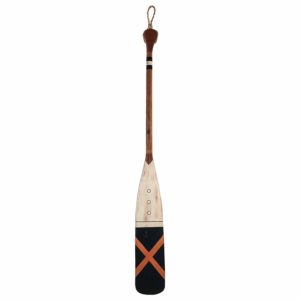
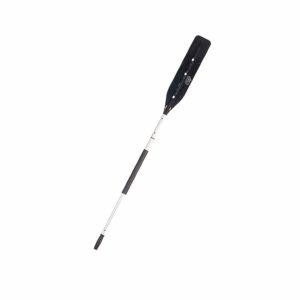
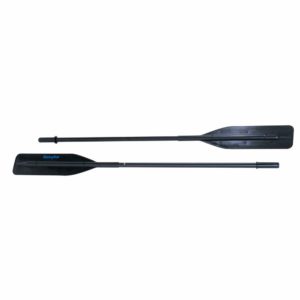
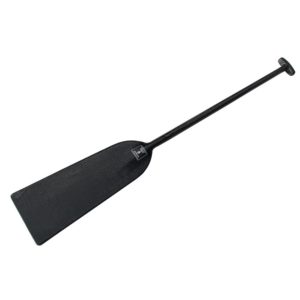
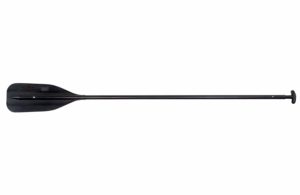
Top 5 Best Oars in 2019
1ESH 60 in. Oar — Most Beautiful Oar
If you want to go eco-friendly and you want even the oars to look cool, this ESH oar is a perfect choice for you.
It features a decorate rope to make the oar—and the boat by extension—even cooler, and it’s made of wood. And, let me tell you, it looks incredible. However, it makes it less suitable for any sort of trips, since the oar is mostly decorative. It’s an excellent oar to boast, but it’s not so good to actually use.
It’s usable, kind of, and if you want oars to show off, this is the choice for you.
But this was just a warmup. Let’s get to more practical oars and paddles.
Pros
- Eco-friendly
- Features a decorate rope
- Made of wood
- It looks awesome
Cons
- Mostly decorative
2Outcast 2-Piece Oar — Best Bang for the Buck
So you want a standard 2-piece oar. Then this beauty is for you. It’s perfectly normal 6 feet oar, one that you can count on to get you out of trouble if the motor dies. Or you’re simply out of fuel.
The breakdown design is pretty reliable, and since it’s a 2-piece, it doesn’t take much space for storage. The downside is that it’s not as durable as 1-piece oars.
You can use it with any standard oarlock. It’s a pretty basic boat oar suitable for any situation.
Pros
- 6 feet oar
- Break down design is pretty reliable
- Doesn’t take much space for storage
Cons
- Not as durable as 1-piece oars
3Sevylor Heavyduty Oars — Best Heavy-duty Oars
Getting a pair of oars is sometimes better than getting just one oar. And this is not a bad oar. It’s robust, light and it’s made of an aluminum alloy and stainless steel. The grips are ergonomic and comfortable to hold, the design is telescopic, and the oars themselves are 59 inches in length.
The blades are pretty narrow, and that makes the oar ideal for long trips.
This oar could be stronger if it were made one-piece. As it is, it’s durable thanks to the material used but not because of the overall structure.
Play Video
Pros
- Robust
- Light
- Made of an aluminum alloy and stainless steel
- Grips are ergonomic and comfortable to hold
Cons
- Could be stronger if it were made one-piece
4ZJ Sport IDBF Paddle — Best Sports Paddle
If you want to get a highly efficient and sophisticated oar, then the ZJ Sport paddle is the way to go. It only has one drawback: it’s very expensive. And it’s also not an oar, it’s a paddle.
But it’s great for any canoe or kayak, and it’s near unbreakable, super light, and has a spoon shape to add some extra boost.
Working it is like a breeze, and if that’s what you like, you’re going to enjoy it. The only thing you may not like is the relatively high price.
Pros
- Highly efficient
- Sophisticated
- Near unbreakable
- Super light
- Has a spoon shape to add some extra boost.
Cons
- Relatively high price
5Carlisle Taboo Paddle — Most Sophisticated Paddle
If you want a paddle rather than an oar and you can afford to spend more than you expected, then this Carlisle Taboo paddle is just the thing for you.
It’s a two-piece paddle with a detachable blade. It makes it super easy to store and transport, but I’m concerned about its strength a bit. That kind of design is not very strong by itself. Thankfully, the shaft is made from aluminum, so there’s that. An excellent paddle for an angler with a kayak.
Play Video
Pros
- Detachable blade
- Super easy to store and transport
- The shaft is made from aluminum
Cons
- Design is not very strong by itself
Buyer’s Guide
How difficult can be choosing a pair of oars? In the year 2019, surprisingly so. We have new materials, not just aluminum alloys but also different plastics. We have new designs, computed on bleeding edge supercomputers. We have thousands of years of collective experience, which manages to come up with a few designs before even the 20th century. Consider all that, and you will understand why it could be a difficult task.
Worry not, though. A difficult task it may be, but if you’re armed with all the knowledge about choosing an oar, doing so will be no problem.
There are several key features you need to take into account when buying your perfect oars. Or a paddle, for that matter. It’s the weight, the length, the shape of the blade, what the oar is made of and so on. That makes pinpointing the ideal pair of oars difficult, but I can tell you what the worst oars will look like right away. They will be long, they will be heavy, and the blades are going to be thick. That’s a terrible combo. If it’s an oar rather than a paddle, throw in a thick shaft as well, because an oar like that will probably not fit through a boat inlet.
That’s no to say a pair of perfect oars in the opposite of that. First, if your oars are too short, that can be just as bad as oversized oars. Plus, you have to mind your own height, your preferred stroke mode, and even your individual taste.
Some factors are universal, though, so let’s just address them in the first place.
Materials
You have an extensive assortment available to you. You have wood, plywood, aluminum and titanium alloys (not always practical and not readily available because of that, titanium oars may be more expensive than your inflatable boat), carbon fiber and other materials that did not emerge until the late 20th century.
Considering all that, let’s just start with the most popular and ancient material.
Wood
There are several vital pros any wooden oar is going to have. One, wooden oars have an outstanding flex. It’s just something that comes naturally to them, it doesn’t have to be designed. Because of that, you can feel your own strokes, and that allows for move efficient rowing. And then there is the matter of aesthetics, of course. Wooden oars look cool, there’s no denying that.
However, wood is probably the most massive oar material of all its modern competitors. You may not feel it when you grab that wooden oar, but your arm is going to feel it later. The longer you work it, the worse it’s going to be.
Carbon Fiber
This option just screams “synthetic.” However, it’s not like its a bad thing. You’re not going to wear the oar, so it doesn’t matter if it’s synthetic or not. It’s not even a real disadvantage.
As for the advantages, they are very much real. First, carbon fiber oars are not much weaker than wood, and they are definitely among the lightest in the industry. You can paddle for a very long time, and that’s a plus, absolutely.
Aluminum
Is the price a concern? That’s what aluminum oars are for. They are dirt cheap. You’d think that metal oars are not the cheapest, but I guess, it speaks volumes about the quality of carbon fiber.
Aluminum is a very light metal, but only as metals go. It’s still heavier than water, but an aluminum oar doesn’t have to be thick to be reliable, and the shaft is usually hollow, so aluminum oars are not going to be very heavy. Not very light, but they are going to feel like a pair of lead weights.
The weight is not a big concern, but aluminum conducts heat very well. Gabbing a metal oar when you’re rowing in freezing water is not fun. To compensate for this drawback, you may have to wear gloves or just get a pair of oars with some insulation upgrades.
Shafts
The shaft is one of the most essential parts of an oar. There’s two of them, and the blade can do only so much of no one is holding the shaft.
There are three parameters an oar shaft can feature that are really important. It’s the thickness of the oars, the number of pieces they are made of and their length.
Thickness
It’s easy to pick, but it’s not something we should overlook. If an oar has more girth that could fit through the inlets on your boat, you’re not using that oar no matter how good it is otherwise.
Length
The length is more complicated. You need to calculate it to size your oars right. Divide the distance between the oarlocks by two, multiply the result by three and add three more inches. If it’s a two-seat boat or more, you need to do the same for each seat.
Design
One-piece shaft works the best. Unfortunately, while they are the most convenient to use and the strongest, they are less than comfortable to store and transport. Oars measure quite a lot in length, and fitting them in the trunk can be a challenge, to say the least. That’s probably why two-piece oars gained more traction than the objectively better one-piece oars.
Three-piece oars and more are quite weak and should be avoided unless they are particularly stiff or have other advantages that nullify that considerable drawback.
Detachable
It’s basically a two-shaft design. It’s pretty straightforward. You can use the short shaft with the blade by itself if you wish, but you wouldn’t be able to use it with an oarlock. The design is meant for storage and transportation, even if it’s dual-purpose.
Telescopic
Exactly what it says. You can get your oar shorter or longer, depending on your needs. It’s invaluable if you have more than one boat or you may have to share the oars with a partner. They can adjust the oar to their desired length without any trouble.
The telescopic design is better in every way except one: the price. Also, some telescopic boats may be weak and prone to breaking, which is why it is crucial to choose only the best boat oars.
Blades
The shape of the blade is not critical, but it’s essential for high performance. There’s no universally good blade shape. Otherwise, there wouldn’t be any choice. Everyone would just be using the same thing. Clearly, that is not the case.
What kind of oar blade you choose depends on where you plan to use that oar.
Width
Broad
If you want to get your boat on the move fast and you really want to keep that pace, there’s nothing better than a pair of broad oars. With them, you can propel the boat forward quite quickly.
Narrow
Narrow blades are not capable of helping to accelerate the boat. You’re going to be moving slow. However, you will still have the strength to row for a long time, and you’re going to cover more distance than you would with a broad blade oar at the end of the day.
Shape
If you don’t want to rock the boat as you row and you want to boost your boat some, you may need spoon-shaped oars. They are more steady than flat blade oars and more efficient, but not every boat can get that boost.
The rule of thumb is a flat blade does not perform any better than a spoon blade, but a spoon-shaped blade made perform better if your boat is a good fit for it.
Questions and Answers
Waterproof clothes seem like reasonable protection against rain, but that’s just appearances. I don’t know if your jacket is waterproof and how good it is, but there’s this thing called waterproof ratings. Most of the regular clothes, even those designed for fishing, have a limit waterproof rating, often less than 5,000 mm. That may be enough for light rain for a brief time, but nothing above that. Textile waterproof gear tends to be quite low on the waterproof rating spectrum unless it’s also lined with membranes, and even the best textile clothing can only hold out for so long.
So even if your regular jacket is waterproof, I recommend having a good rain suit on hand, because if you expect to be in the rain all day long (which you will if you regularly spend your time casting the bait) or in icy conditions, you are going to want that protection. Besides, it feels quite nice to throw on that extra layer on the outside. It’s going to give you a complete blockage of water and wind. As you can guess, it will instantly make you comfortable, no matter how cold and wet it is out.
